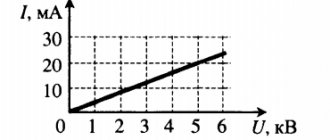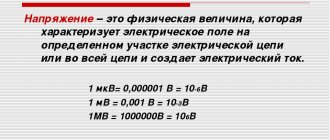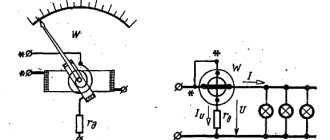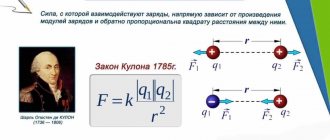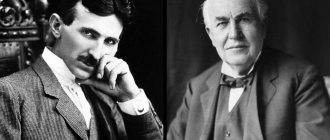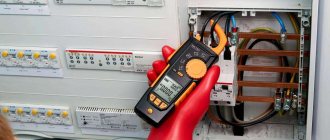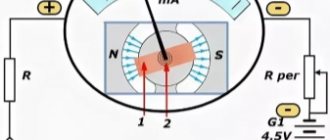What is the difference between ampere and kilowatt
The fundamental difference between the units of measurement of electrical network parameters, which are included in the title of this section, is that they represent a numerical measure of various physical quantities.
In this case:
- amperes (abbreviation A) show current strength;
- watts and kilowatts (abbreviation W and kW, respectively) characterize active (actually useful) power.
In practice, an expanded description of power is also used, measuring it in volt-amperes and, accordingly, kilovolt-amperes, which are briefly referred to as VA and kVA.
They, unlike W and kW, which describe active power, indicate total power.
In DC circuits, the apparent and active powers are the same. Similarly, in an AC network, with a small load power, at the engineering level of rigor, the difference between W (kW) and VA (kVA) can be ignored, i.e. work only with the first two units.
For such circuits the following simple relation applies:
W = U*I, (1)
where W is the (active) power specified in W, U is the voltage specified in volts, I is the current measured in amperes.
When the load power increases to a level of a thousand watts and above for direct current, relation (1) does not change, but for alternating current it is advisable to write it as:
W = U*I*cosφ, (2)
where cosφ is the so-called power factor or simply “cosine phi”, showing the efficiency of converting electric current into active power.
In physical meaning, φ represents the angle between the vectors of alternating current and voltage or the phase shift angle between voltage and current.
A good criterion for the need to take this feature into account are those cases when VA or kVA are indicated instead of kW in the nameplate data and/or on the body nameplates of electrical appliances, mainly powerful ones with a consumption of more than 1 kW.
Typically, for household electrical devices with powerful electric motors (washing machines, dishwashers, pumps and the like) you can set cosφ = 0.85.
This means that 85% of the energy consumed is useful, and 15% forms the so-called reactive power, which continuously transfers from the network to the load and back again until it is dissipated in the form of heat during these transitions.
At the same time, the network itself must be designed specifically for full power, and not for useful power. To indicate this fact, it is indicated not in watts, but in volt-amperes.
As a unit of measurement, the watt (volt-ampere) is sometimes too small, resulting in numbers that are difficult to visually perceive with many digits. Taking this feature into account, in some cases power is indicated in kilowatts and kilovolt-amperes.
For these units the following is true:
1000 W = 1 kW and 1000 VA = 1 kVA. (3).
How to convert Amperes to Kilowatts in a three-phase network
Watt = √3 * U * I;
√3 = 1,732;
P = √3 * U * I;
Ampere = W /(√3 * V)
I = P / √3 * U
Task. Calculate the power of a three-phase water heater. When it is operating, the current clamp shows a load of 3.8 A.
P = 1.732 * 380 * 3.8 = 2501
Answer: The power of the water heater is 2.5 kW.
Note. The numbers may be completely different, depending on the heater control circuit.
Let's summarize. Using the above formulas, selecting materials for repair or installation will not be difficult, even for people who do not have an electrical engineering education.
To reinforce the information, watch a video on the topic. It is created a little old-fashioned, but useful and educational.
Also read: Calculation of the power of a three-phase network.
I will end here. Write your questions in the comments. If the article was useful, then click on the social media buttons. Until next time. Bye.
Sincerely, Semak Alexander!
Why is there a need to move from amperes to kilowatts and back?
It is impossible to reduce the description of an electrical network to just one unit. The need to use two different units of measurement of parameters arises due to the fact that in the vast majority of cases, a particular wiring serves several consumers, each of which contributes to the strength of the flowing current.
As a result
- It is convenient to calculate the cross-section of the wires based on the maximum strength of the current flowing through them;
- circuit breakers that protect receivers and wires from overload and short circuit are selected in the same way;
- The main characteristic of any electrical device connected to a socket as a current collector or load is traditionally its power.
The popularity of indicating power consumption, as one of the main parameters of an electrical appliance, is also determined by the fact that payment for electricity is carried out using an electric meter, which is calibrated in kWh.
Accordingly, given the known cost of one kW*hour, payment for electricity is determined by simply multiplying three numbers: power, operating time and cost of one kW*hour.
Taking into account the peculiarities of determining electricity costs, it becomes clear the advantage of using for powerful devices not useful power, measured in kW, but total power, which is determined in kVA.
It is advantageous in that it makes it possible to perform calculations using a single method without separately taking into account the actual phase shift of current and voltage.
The principle of identical calculations when knowing the total power also applies to current calculations.
The conversion from one unit to another is carried out according to the relations (1) and (2) presented above and, due to their simplicity, does not pose any big problems.
In this case, the fact that voltage U can be considered a constant, which varies only depending on the number of wiring phases, plays a role.
Below we present the basic rules for performing such calculations in relation to the most common cases in practice.
Watt, kilowatt and kilowatt-hour
The unit of measurement watt got its name in honor of the scientist James Watt, who studied electricity in the nineteenth century. It is he who is credited with the invention of the universal steam engine.
Today, any power is measured in watts, not just electrical power. For example, to measure the power of a car engine, watts are also used along with horsepower. However, most often it is not the “watt” itself that is used, but its derivative, the kilowatt (kW). By analogy with the meter and kilometer, as well as with the gram and kilogram, one kilowatt is equal to a thousand watts.
Energy is often also calculated in other units, multiples of the watt. For example, to measure high power it is convenient to use the megawatt, a unit that corresponds to a million watts. You can also use other prefixes of the international system of units, including those that correspond to tenths, hundredths, thousandths.
For example:
- deciwatt is a tenth of a watt;
- centiwatt - its hundredth part;
- A milliwatt is a thousandth of a watt.
The electric power that is consumed by ordinary household appliances such as lamps, refrigerators, and TVs is best measured in kW. If the watt and its derivative units are included in the SI system, then the kilowatt-hour is not there. KWh is a unit of measurement that is non-systemic. It was created only to keep track of the electrical energy produced or, conversely, used.
The use of kWh on the territory of the Russian Federation is regulated by GOST, which clearly indicates the name, designation and area in which it is used. A kilowatt-hour can be designated either by four Russian letters or three English ones. The Russian designation is “kWh”, and the English designation is “kW h”.
You might be interested in what electrical tape is needed for: types and melting point
Determination of power by current strength for a single-phase network
The need to perform this procedure most often arises when setting restrictions on the maximum power of an electrical appliance that can be connected to a specific outlet or group of outlets.
If this restriction is violated, the risk of fire increases, and the plastic decorative elements of the outlet may melt due to excess heat generated.
Based on the definitions, which are described in mathematical form by expressions (1) and (2), to find the power, you simply multiply the current by the voltage.
The maximum permissible current is indicated on the outlet marking and for most indoor household products of this type is usually 6 A.
The voltage supplied from the mains to the outlet is 220 - 230 V. Thus, the maximum power is 1.3 kW.
Separately, we point out that the risks of damage to the outlet when connecting an overly powerful device are minimal in properly designed household wiring.
This useful property is provided by:
- installation of automatic machines;
- the use of plugs in powerful electrical appliances that physically cannot be connected to conventional sockets (mechanical interlocking).
A rather popular direct connection of a powerful stationary device (air conditioner, boiler) to the network without the use of sockets can be considered a unique version of mechanical interlocking.
Single-phase network
In Russia, the CIS countries and some other countries, the voltage of a single-phase network is 220V and, despite the fact that the actual parameters of the network may differ in any direction, this value is used when calculating the cross-section of wires and settings of circuit breakers.
Therefore, the formulas for converting amperes to kilowatts and vice versa are as follows:
- Determination of current strength . For this, the expression I=P/U=P/220 is used. In this case, it is allowed to use a simplified version of the calculation I(A)=Р(kW)*4.45≈Р(kW)*5.
- Calculation of permissible power . In the event that there is a cable or automatic machine, then to determine the power of electrical appliances, the formula P=U*I=220*I or P(kW)=I(A)/4.5≈I(A)/5 is used
The use of simplified calculation options is to some extent more correct, since this automatically adds the necessary margin of cable cross-section or machine setting.
Conversion of power to current for a single-phase network
Current calculation is usually performed in the process of selecting a machine that serves a powerful consumer such as a direct-flow water heater.
Based on expressions (1) and (2), the problem is solved in one action. To do this, simply divide the power by the voltage.
The power value is given in the technical description of the device or indicated directly on its body. The voltage is assumed to be 220 V, which creates some calculation margin.
For example, with a power of 3000 W, in accordance with the above rule, we obtain a current of 3000/220 = 13.7 A, which indicates the need to use a 16-amp circuit breaker.
When specifying power in kilowatts, one step is added to the calculation: you must first convert kilowatts to watts, taking into account formula (3).
For example, the heater has a power of 2.8 kW. Then the current calculation is performed as follows:
- W = 2.8*1000 = 2800 W;
- I = W/220 = 12.7 A.
If the power is indicated in VA or kVA, then the calculation does not change, i.e. 3000/220 = 13.7 A (in the second case, we first convert kVA to simple VA, i.e. 3 kVA = 3*1000 = 3000 VA).
The main feature in this case is that, taking into account the typical cosφ = 0.85 for household devices, useful work will be performed by 11.6 A (i.e. 85% of the total current), while the remaining 2.1 A is reactive current, which is uselessly spent on heating the wires.
Quick assessment of currents and powers
The extreme simplicity of the initial relations (1) and (2) makes it possible to significantly simplify the execution of current calculations with the additional condition of specifying the power in kilowatts.
The basis for simplifying the calculations is the fact that, taking into account the approximate constancy of voltage in a household single-phase 220-volt network, the conversion of power into current can be performed by multiplying the power by a constant factor.
To determine such a coefficient, it is advisable to use the fact that when setting W in kW, we have a fairly accurate estimate I = W*1000/220 = 4.5*W.
For example, with W = 2.8 kW we get 4.5 * 2.8 = 12.6 A, i.e. calculations are performed faster and much more conveniently compared to “correct” calculations with a slight loss of accuracy.
Similarly, it is equally easy to show that W = 0.22*I kW. It must be remembered that current I is indicated in amperes.
Thus, we get simple rules:
- one kW corresponds to 4.5 A current;
- one ampere corresponds to a power of 0.22 kW.
The latter rule is often rounded down to one ampere equivalent to 0.2 kW.
Relationship between power and current in a three-phase network
The principle of calculating power and current for three-phase networks remains the same. The main difference is a slight modernization of the calculation formulas, which allows us to fully take into account the design features of this type of wiring.
The following expression is traditionally taken as a basic relationship:
W =1.73* U*I, (4)
and U in this case represents the linear voltage, i.e. is U = 380 V.
From expression (4) follows the advantage of using three-phase networks in justified cases: with such a wiring diagram, the current load on individual wires drops to the root of three times with a simultaneous threefold increase in the power supplied to the load.
To prove the last fact, it is enough to note that 380/220 = 1.73, and taking into account the first numerical coefficient we get 1.73 * 1.73 = 3.
The above rules for the connection of currents and power for a three-phase network are formulated in the following form:
- one kW corresponds to 1.5 A of current consumption;
- one ampere corresponds to a power of 0.66 kW.
Let us point out that everything that has been said is true in relation to the case of connecting the load with a so-called star, which is most often encountered in practice.
A triangle connection is also possible, which changes the calculation rules, but it is quite rare and in this situation it is advisable to contact a specialist.
Calculation features
Despite the fact that the power of electrical appliances is often indicated on their cases, you still often have to independently calculate how much electricity a particular household appliance consumes. In order not to make mistakes when calculating and to come to the correct result, you need not only to know about the differences between kW and kW-hours, but also to be able to convert these values from one to the other. For example, power often needs to be converted into energy and vice versa.
Before you start calculating the energy consumed by a particular household electrical appliance, you need to prepare a calculator, since the numbers may turn out to be such that it will be quite difficult to operate with them in your head.
Before converting power into energy, that is, kW per kWh, it is necessary to clarify what was previously measured. If the meter readings were measured, then everything will be extremely simple. It is enough just to correct “kilowatt” to “kilowatt-hour”.
You may be interested in this. Designation of the unit of measurement W (watt)
The meter reading is the energy consumed by electrical appliances per unit of time. It is also measured in kilowatt-hours. It’s just that in everyday life the name of this unit has lost the word “hour”. As a result, it became abbreviated to simply kW. Quite often, owners of any household electrical appliance convert kW to kW-hours in order to determine how much energy is consumed during its operation and, therefore, how often it needs to be turned on.
If the device consumes too much energy, you will have to use it rarely to save energy. In order to accurately determine how much energy this or that equipment, for example, an electric heater, will require, you need to know its operating time and power, which is usually indicated on the housing. For example, if the power of the device is 2 kW, and it works for 3 hours, then as a result of simple mathematical multiplication you can find out that the total electricity consumption during this time is 6 kilowatt-hours.
Minor problems may arise when calculating energy consumption if the power is indicated in units other than kW. The situation will get worse if time is also measured not in hours, but, for example, in minutes. Then, before starting calculations, it is necessary to convert power units into kW, and time units into hours. Only in this case the calculation results will be correct.
As an example, we can take an ordinary lamp, the manufacturers of which claim that its power is 100 W. Let's say you need to determine how much electricity is used if it burns all day. The power of the light bulb should be determined in kilowatts. Since Watt (watt) is a unit that is a thousandth of a kilowatt, you simply divide this light bulb wattage value by 1000.
That is, 100 W is divided by 1000 and the result is 0.1 kilowatt. This completes the conversion from one unit of power to another.
It is necessary to convert the time indicator to the desired unit. The condition requires determining how much energy the lighting device will consume per day. It’s simple here: there are 24 hours in a day, and therefore this figure can be considered the result of converting time units. All that remains is to multiply the numbers obtained as a result of the translation and find out how much energy will be consumed by the light bulb. 0.1 kilowatt is multiplied by 24 hours, and the resulting number is 2.4. This means that the energy consumption of the device is 2.4 kWh.
You might be interested in How to make a 220 to 12 volt transformer with your own hands
This way you can determine not only the amount of energy consumed by any one device, but also the total energy consumption of all electrical equipment in the house. The main thing is to know the duration of its operation and power.

